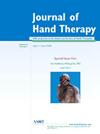Activity limitations related to cold hypersensitivity in patients with hand injuries
IF 2.1
4区 医学
Q2 ORTHOPEDICS
引用次数: 0
Abstract
Background
Knowledge of specific activity limitations due to cold hypersensitivity is sparse.
Purpose
To explore activity limitations caused by cold hypersensitivity and the associated environmental factors in patients with hand injuries.
Study design
Descriptive study.
Methods
Seventy-seven patients with multiple tissue hand injuries described activity limitations related to cold hypersensitivity in questionnaires six and/or 12 months after surgery. To characterize the activity limitations, we performed a quantitative content analysis applying the International classification of functioning and health (ICF).
Results
The respondents described on average 3.6 cold related activity limitations in leisure and/or work. The activities were most frequently (n) assigned to the ICF domains d920 Recreation and leisure (95), d440 Fine hand use (77), and d850 Remunerative employment (39). The most common related environmental factors were Products and technology for e140 Culture, recreation and sport (79) and for e135 Employment (71), respectively, and e225 Climate (71). Gloves were both a facilitator and a barrier for activity performance.
Conclusion
The impact of cold hypersensitivity on activity was related to both the activity and the environment. The results call for clinical interventions and product development, for example of gloves, to help patients solve their cold related activity limitations.
手部受伤患者因对寒冷过敏而导致活动受限。
研究背景:人们对冷过敏症导致的具体活动限制知之甚少:目的:探讨手部损伤患者因冷觉过敏而导致的活动限制以及相关的环境因素:描述性研究:77名手部多组织损伤患者在术后6个月和/或12个月的调查问卷中描述了与冷过敏症相关的活动限制。为了描述活动限制的特征,我们采用国际功能与健康分类(ICF)进行了定量内容分析:结果:受访者平均描述了 3.6 项与感冒有关的休闲和/或工作活动限制。这些活动最常(n)被归入 ICF 领域 d920 娱乐和休闲(95)、d440 手部精细操作(77)和 d850 有偿工作(39)。最常见的相关环境因素分别是 e140 文化、娱乐和体育(79 人)和 e135 就业(71 人)的产品和技术,以及 e225 气候(71 人)。手套既是活动表现的促进因素,也是活动表现的阻碍因素:结论:低温过敏症对活动的影响与活动和环境有关。结论:冷过敏症对活动的影响与活动和环境都有关系,因此需要进行临床干预和产品开发,例如手套,以帮助患者解决与寒冷有关的活动限制问题。
本文章由计算机程序翻译,如有差异,请以英文原文为准。
求助全文
约1分钟内获得全文
求助全文
来源期刊

Journal of Hand Therapy
医学-外科
CiteScore
3.50
自引率
10.00%
发文量
65
审稿时长
19.2 weeks
期刊介绍:
The Journal of Hand Therapy is designed for hand therapists, occupational and physical therapists, and other hand specialists involved in the rehabilitation of disabling hand problems. The Journal functions as a source of education and information by publishing scientific and clinical articles. Regular features include original reports, clinical reviews, case studies, editorials, and book reviews.
 求助内容:
求助内容: 应助结果提醒方式:
应助结果提醒方式:


